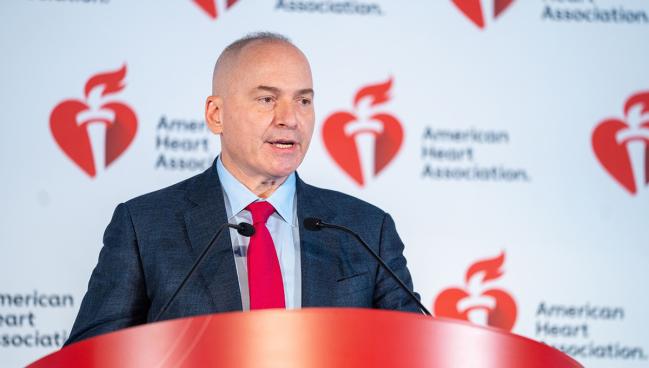Long-Awaited BEST-CLI Results Favor Surgery Over Endovascular Therapy in CLTI
The highly selected, mostly white, male population has some physicians questioning the generalizability of the results.

Photo Credit: AHA/Zach Boyden-Holmes 2022. Used with permission.
In patients with chronic limb-threatening ischemia (CLTI) and suitable anatomy, surgery results in fewer major adverse limb events (MALE), major limb interventions, and amputations than endovascular therapy, according to data from the BEST-CLI trial. Quality-of-life (QoL) data from the trial showed trends favoring endovascular therapy, but similar overall improvement for patients who underwent either type of revascularization.
“Our trial is level-one evidence that does not support an endovascular-first approach to all patients,” BEST-CLI lead investigator Alik Farber, MD (Boston Medical Center, MA), told TCTMD. BEST-CLI is the largest head-to-head comparison of endovascular therapy and surgery in people eligible for either treatment, having enrolled 1,830 patients from 150 centers in the United States, Canada, Italy, Finland, and New Zealand. Farber presented the results today in a late-breaking session at the American Heart Association 2022 Scientific Sessions, and they were simultaneously published in the New England Journal of Medicine.
Farber and colleagues found that in patients who had an adequate single segment great saphenous vein (SSGSV) that could be used for bypass surgery, 42.6% of those treated with surgery and 57.4% treated with endovascular intervention had a primary outcome event (P < 0.001), which was a composite of MALE or all-cause death at a median follow-up of 2.7 years.
In patients who did not have an SSGSV but had an alternative conduit, 42.8% of those treated with surgery had a primary outcome event compared with 47.7% of those in the endovascular group (P = 0.12), a nonsignificant difference at a median follow-up of 1.6 years. Those who underwent surgery had 32% fewer major medical events related to CLTI, driven by a 65% reduction in major reinterventions and a 27% reduction in above-ankle amputations. The differences emerged within the first 6 months in favor of surgery, with 42.5% of first reintervention events occurring within 30 days.
“Bypass with adequate saphenous vein or single segment saphenous vein is a more effective strategy for patients who are suitable for both open and endovascular approaches,” Farber said. “Patients who are candidates for limb salvage should undergo an evaluation for surgical risk and should have vein mapping to see if they have a good conduit.”
Rates of MACE also were similar between surgical and endovascular groups at 30 days and over the trial’s full follow-up. “That kind of surprised us because we know there's always a sense that surgery is associated with more risk, at least around 30 days. But we did not find that,” Farber added.
Low Enrollment of Key CLTI Patients
In the prespecified QoL analysis, presented by BEST-CLI co-author Matthew Menard, MD (Harvard Medical School, Boston, MA), patients saw improvements from baseline out to 4 years regardless of revascularization type, based on patient-reported surveys that ranged from measures of pain and activities of daily living to physical activity level and mental health.
Naomi Hamburg, MD (Boston University Chobanian & Avedisian School of Medicine, MA), who served as the discussant following the presentations, noted that BEST-CLI was intended to address the optimal strategy for revascularization of CTLI patients in the setting of clear equipoise, limited prior outcome data, and a strong clinical need. But she also noted the relatively low enrollment of women and Black patients, and high burden of CV risk factors and disease, with limited penetration of guideline-directed medical therapy, which may have differentially impacted outcomes in the endovascular and surgical groups.
“It's important to think about who did not make it into the study and whether there could be bias,” Hamburg said. “Patients who were not deemed to be candidates for either, that might have been at high cardiovascular risk or frail, were not enrolled. One has to consider whether there was differential enrollment after evaluation of the angiogram, whether patients who were deemed poor surgical candidates or easy endovascular did not make it into the trial.” She further pointed out that patients with SSGSV, who were overly represented in BEST-CLI, are only a subset of the CLTI patient population.
We need more use of statins and antithrombotic agents to try and prevent patients from ever developing CLTI, because this shows you just how morbid and bad it is for patient outcomes. Geoffrey Barnes
That thought was echoed by Sahil Parikh, MD (NewYork-Presbyterian/Columbia University Irving Medical Center, New York, NY), who commented on the findings for TCTMD, saying that he believes the trial methodology is inherently flawed and requires further scrutiny before it can claim a victory for surgery.
“Very few of my CLTI patients have adequate veins to do bypass, and that combined with the fact that my patient population are overwhelmingly Dominican makes me wonder if these results would be generalizable to people other than white men,” he said. “I worry that this is a disservice in some ways to patients because it will misinform their management.”
Asked if he expected pushback from endovascular specialists, Farber told TCTMD, “I hope not,” adding that the executive committee included representatives from all specialties who treat patients with CLTI.
“So, this was designed by a multidisciplinary group who really thought very hard about how to best designs trials,” he said. “Some people may not like it, but I think it'll help treat patients.”
Data Differ by Cohort
For BEST-CLI, Farber and colleagues grouped CLTI patients into one of two cohorts. Cohort 1 consisted of 1,434 patients (mean age 67 years; 28.5% female; 19% Black) with an adequate SSGSV for bypass. Cohort 2 consisted of 718 patients (mean age 68.6 years; 28% female; 24.6% Black) with an alternative conduit for bypass, including prosthetic grafts. Three-quarters of participating sites had multidisciplinary CLTI teams that included some combination of vascular surgeons, interventional cardiologists, and interventional radiologists, but only 13% had all three, with 28% of all sites having only vascular surgeons performing surgical and endovascular procedures.
In cohort 1, the rate of major reinterventions was 9.2% in the surgical group versus 23.5% in the endovascular group (HR 0.35; 95% CI 0.27-0.47). Above-ankle amputations of the index limb occurred in 10.4% of patients in the surgical group and in 14.9% of those in the endovascular group (HR 0.73; 95% CI 0.54-0.98). Rates of death from any cause were similar between the surgery and endovascular groups (HR 0.98; 95% CI 0.82-1.17). There was no difference between groups in MACE, MI, or stroke events occurring overall or at 30 days.
In cohort 2, there were no significant between-group differences in the primary endpoint (P = 0.12) or in safety outcomes, which Farber and colleagues say “emphasize the importance of individualized patient-level decision-making in patients without an appropriate bypass conduit.”
Surgical patients in both cohorts had longer hospital stays than those who underwent endovascular procedures.
The QoL data showed that while there were no differences between surgery and endovascular treatment on any health-related QoL measure among patients in cohort 2, endovascular therapy was statistically superior on several patient-reported instruments in cohort 1. However, those differences were considered small and below the threshold of clinically meaningful difference, Menard said in his presentation. He acknowledged missing follow-up QoL data among trial participants, adding that nonresponse among patients who had undergone an amputation may have introduced bias.
Ongoing Methodology Questions
For her part, Hamburg also said many questions remain about BEST-CLI, including drilling down into optimal endovascular approaches, given rapid changes in the field. In particular, 15% of patients in the endovascular arm had early technical failure, she said, raising questions about how those patients were treated.
Not only how they were treated, but also by whom, added Parikh, who said he enrolled several of his patients in the trial. With so many of the operators in BEST-CLI being surgeons rather than endovascular specialists who do these procedures all the time, he said it raises red flags about who should be doing endovascular interventions.
“They have a surprisingly high mortality rate for endovascular procedures, and I wonder if it's because surgeons did endovascular therapy under general anesthesia, which is fairly common in the surgical world,” he said. Parikh also noted high rates of plain old balloon angioplasty (POBA) in endovascular interventions rather than standard-of-care drug-coated devices and atherectomy.
In his presentation, Farber acknowledged possible selection and operator bias in enrollment and intervention, as well as the lower-than-anticipated enrollment of women. He also made the point that use of paclitaxel-coated devices in the trial was affected by the 2018 publication of a meta-analysis of 28 RCTs, led by Konstantinos Katsanos, MD, PhD (Patras University Hospital, Rion, Greece), that showed excess late mortality starting at 2 years in patients treated with a paclitaxel-costed balloon or stent versus noncoated devices. Following publication of that meta-analysis, use of paclitaxel-coated devices came to a halt for a while in the US and Europe.
Hamburg further pointed out that the QoL data are not in sync with the primary endpoint. “It kind of makes sense that patients with endovascular therapy would have a quicker recovery, but it's more perplexing to understand how a reduction in amputation and a reduction in intervention didn't lead to an improved quality of life in the surgical intervention groups,” she said.
Geoffrey Barnes, MD (University of Michigan, Ann Arbor), who also commented on the findings for TCTMD, said the BEST-CLI experience highlights just how incredibly high-risk CLTI patients are, with adverse event rates over 40% regardless of treatment group.
“It really tells us that these are very sick patients that do need therapy, not just when they present with the CLTI, but well in advance of that presentation,” he said. “This is a call to action that we need to do better for these patients with vascular disease. We still need better medical therapies. We need more use of statins and antithrombotic agents to try and prevent patients from ever developing CLTI, because this shows you just how morbid and bad it is for patient outcomes.”
Barnes said while he too wishes the trial was more representative of patients in the overall CLTI population, large efforts like BEST-CLI have to contend with complicated site and patient issues, particularly who is willing to be randomized.
L.A. McKeown is a Senior Medical Journalist for TCTMD, the Section Editor of CV Team Forum, and Senior Medical…
Read Full BioSources
Farber A, Menard MT, Conte MS, et al. Surgery or endovascular therapy for chronic limb-threatening ischemia. N Engl J Med. 2022;Epub ahead of print.
Menard MT. Quality of life in patients with chronic limb threatening ischemia treated with revascularization. Presented at: AHA Scientific Sessions. November 7, 2022. Chicago, IL.
Disclosures
- BEST-CLI was funded initially by the National Heart, Lung, and Blood Institute. Funding during follow-up was provided by VIVA, the Society for Vascular Surgery, the New England Society for Vascular Surgery, the Western Vascular Society, the Eastern Vascular Society, the Midwest Vascular Surgery Society, the Southern Association of Vascular Surgeons, the Canadian Society for Vascular Surgery, the Society for Clinical Vascular Surgery, the Society of Interventional Radiology, the Vascular and Endovascular Surgery Society, the Society for Vascular Medicine, Janssen, Gore; Becton Dickinson and Company, Medtronic, Cook, Boston Scientific, Abbott, Cordis, and Cardiovascular Systems, Inc.
- Farber reports concluding for Sanifit.
- Menard reports consulting for Janssen.





Comments